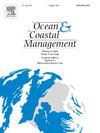A high-resolution coastal risk assessment framework: Integrating knowledge driven and machine learning models for the Andhra Pradesh coastline
IF 5.4
2区 环境科学与生态学
Q1 OCEANOGRAPHY
引用次数: 0
Abstract
Coastal regions face increasing threats from climate change and anthropogenic activities worldwide, and more sophisticated risk assessment tools are needed. This study introduces and applies a novel hybrid framework for coastal risk assessment, integrating a knowledge driven analytic hierarchy process (AHP) model with a data driven eXtreme Gradient Boosting (XGBoost) predictive model. The framework was applied to 55 coastal villages along the Andhra Pradesh coastline in India, a region frequently exposed to hydrometeorological hazards. A comprehensive coastal risk index (CRI) was computed using 18 variables encompassing geophysical hazards, socioeconomic vulnerabilities, and adaptive capacities. The AHP model, which is based on expert-weighted pairwise comparisons, produces internally consistent and reliable variable weights. The XGBoost model was subsequently trained to predict the AHP-derived risk classes, serving as a data-driven validation of the expert-based framework. Statistical validation through ANOVA confirmed that the five risk classes (very low to very high) were statistically distinct. Multiple linear regression revealed shoreline change, coastal slope, and population growth as significant positive drivers of risk. Crucially, the analysis revealed that improving accessibility to cyclone shelters and road networks offered the most substantial potential for risk reduction. While strong agreement (Cohen's kappa = 0.83) was observed between the AHP and XGBoost classifications, indicating a strong alignment between expert knowledge and data patterns, the XGBoost model's low predictive accuracy (0.41) on a limited validation set suggests the need for more extensive data for developing a standalone predictive tool. The outputs of this study, including a high-resolution risk map, provide actionable intelligence for policymakers to formulate targeted interventions. This research contributes a replicable methodology for monitoring progress towards UN Sustainable Development Goals 13 (Climate Action) and 14 (Life Below Water) by providing a quantifiable measure of coastal resilience.
高分辨率沿海风险评估框架:整合安得拉邦海岸线的知识驱动和机器学习模型
沿海地区面临着全球气候变化和人为活动日益严重的威胁,需要更复杂的风险评估工具。本研究引入并应用了一种新的沿海风险评估混合框架,将知识驱动的层次分析法(AHP)模型与数据驱动的极限梯度提升(XGBoost)预测模型相结合。该框架应用于印度安得拉邦海岸线沿线的55个沿海村庄,该地区经常受到水文气象灾害的影响。利用包括地球物理灾害、社会经济脆弱性和适应能力在内的18个变量计算了综合沿海风险指数(CRI)。AHP模型是基于专家加权两两比较,产生内部一致和可靠的变量权重。随后对XGBoost模型进行训练,以预测ahp衍生的风险类别,作为基于专家的框架的数据驱动验证。通过方差分析进行统计验证,证实了五个风险等级(非常低到非常高)具有统计学差异。多元线性回归显示,海岸线变化、海岸坡度和人口增长是风险的显著正驱动因素。至关重要的是,分析表明,改善气旋避难所和道路网络的可及性为减少风险提供了最巨大的潜力。虽然AHP和XGBoost分类之间存在很强的一致性(Cohen的kappa = 0.83),表明专家知识和数据模式之间存在很强的一致性,但XGBoost模型在有限验证集上的低预测精度(0.41)表明需要更广泛的数据来开发独立的预测工具。本研究的产出,包括高分辨率风险图,为决策者制定有针对性的干预措施提供了可操作的情报。本研究为监测联合国可持续发展目标13(气候行动)和14(水下生命)的进展提供了一种可复制的方法,提供了沿海恢复力的可量化测量。
本文章由计算机程序翻译,如有差异,请以英文原文为准。
求助全文
约1分钟内获得全文
求助全文
来源期刊

Ocean & Coastal Management
环境科学-海洋学
CiteScore
8.50
自引率
15.20%
发文量
321
审稿时长
60 days
期刊介绍:
Ocean & Coastal Management is the leading international journal dedicated to the study of all aspects of ocean and coastal management from the global to local levels.
We publish rigorously peer-reviewed manuscripts from all disciplines, and inter-/trans-disciplinary and co-designed research, but all submissions must make clear the relevance to management and/or governance issues relevant to the sustainable development and conservation of oceans and coasts.
Comparative studies (from sub-national to trans-national cases, and other management / policy arenas) are encouraged, as are studies that critically assess current management practices and governance approaches. Submissions involving robust analysis, development of theory, and improvement of management practice are especially welcome.
 求助内容:
求助内容: 应助结果提醒方式:
应助结果提醒方式:


